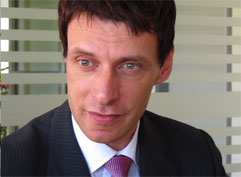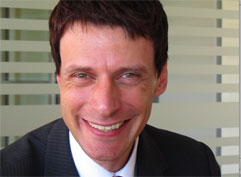 Contact!
Talk To Geoffrey Contact!
Talk To Geoffrey
 Dear Geoffrey,
Dear Geoffrey,
Please allow me to join the fray with regard
to CNS and its possible relevance to a broader arena (Europe, the world?)
or role as a "game-changer,” to use your own phrase. My friend
and colleague, Dr. Otto, has appropriately opened or re-opened a debate
at CNS, and we will all benefit from an exchange of views.
I consider it futile and confusing to jump into
the discussion without clarifying first what good things we associate
with CNS. As a European-based business leader, what I associate and appreciate
with CNS are the following:
1. An annual event that is considered a highlight
of the calendar, it brings together top executives from a wide spectrum
of our top U.S. customers, airlines and other suppliers. The format allows
everyone to catch up to discuss or solve bilateral business issues during
the event. This is by far better than trying to manage a hectic, expensive
and time-consuming schedule of flitting from city to city in the oft times
vain hope of catching the right people at the right time. In short, it
is a first-class networking event for forwarders, airlines and others.
And because it brings together the main stakeholders in the supply of
air logistics, the quality of public debate has often been superior to
what you expect from most industry events.
2. Although I have not personally been involved
in CNS Board or Committee meetings, it is the opinion of my U.S.-based
colleagues that industry representatives at CNS have done their due diligence
in preparing the conference and driving the discussion of issues in a
professional manner and with high enthusiasm.
Now when we ask ourselves whether the CNS concept
can be expanded or exported, we have to first ask ourselves what is missing
in the other main trading areas (mainly Europe or Asia). What is certainly
missing is an event that brings together such a large number of our top
customers. However, we should understand and respect that besides the
obvious lack of a tradition and the reputation that grows out of it, there
is an obvious diversity of practice, culture and language in these other
continents, which makes a "CNS Europe” or a "CNS Asia”
unlikely. While a "CNS" in a quasi-continent like China or India
would work, that already exists with e.g. ACAAI, which is well attended
by both forwarders and airlines.
For sure, IATA cannot fill the gap as it is an
airline body, any more than FIATA could, as it is a forwarder body. But
do we not have TIACA, which is an industry body and includes all main
stakeholders in the air industry? So instead of focusing the debate on
the vehicle (CNS, TIACA, etc.), let us focus on the desired content (issues
and results) in our exchanges, be they via blogs, e-magazines or industry
events, and then allow practical considerations of language and territory
determine whether we use local, continental or global platforms.
If globalization and the spread of the internet
have taught us anything, it is that the game is no longer about one platform
versus another, but about smart networking of any and all platforms: the
existing links between TIACA and IATA, or between IATA and C2K, are good
baby steps, but we have a long, long way to go in opening up our boundaries
and developing a worldwide air cargo web.
My very best wishes to you and all your readers.
Oliver
Oliver Evans
Chief Cargo Officer
----------------------------------------
Swiss International Air Lines Ltd.
PO Box
CH-8058 Zürich Airport
Tel +41 (44) 564 5001
Fax +41 (44) 564 5003
Email oliver.evans@swiss.com
 Dear
Geoffrey, Dear
Geoffrey,
First, let me say that I enjoy reading FlyingTypers.
FT keeps me up to date on what
is going on, and lets me know if something is wrong.
The recent comments by Dr. Andreas Otto,
and my old pal Buz Whalen, bring back memories of when I was the Top Cargo
Virgin.
It seems CNS has become a business, offering
and sometimes capitalizing on the needs of the forwarders and carriers.
The services provided by CNS are necessary,
but there needs to be some flexibility in industry discussions and how
they are conducted when trying to solve industry problems.
When CNS was first established, we heard
from the airlines, and later added forwarders to our board.
We had good talks and spoke frankly about
what we both needed to make profits.
After all, that is what all good business
is about – making profit.
We were on the way to making this happen.
Virgin was against the use of the word partnership,
as it did not really fit.
We believed that the word “cooperative”
better described what we were doing at CNS.
There were only a few who agreed, and so
we ended up with the CNS Partnership.
A Partnership implies working closely together
to achieve our profit goals, but today that does not seem to be the case.
IATA, a worldwide organization, has imposed
its will on CNS, making it a department of IATA as opposed to a stand
alone organization that would represent industry needs.
Until IATA allows for freedom of speech,
CNS will go nowhere.
If CNS wants to grow worldwide or in any
other measure perhaps it should be privatized with cargo people to run
the show.
That is my two cents on the subject.
Sincerely,
Angelo Pustateri
(Editor’s Note: Angelo put Virgin Atlantic Cargo into business
in America and then moved up to retirement and teaching at Hofstra University.
Today, Angelo, who was so much a part of everyone’s air cargo story
for more than 20 years, says life is about his “eight grandchildren,”
although we are happy to report that events in our business occasionally
tag his interest.)
|








